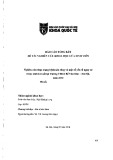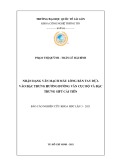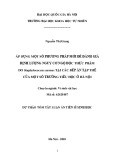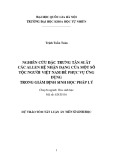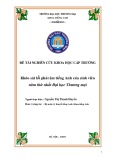
BioMed Central
Page 1 of 12
(page number not for citation purposes)
Cough
Open Access
Research
Classification of voluntary cough sound and airflow patterns for
detecting abnormal pulmonary function
Ayman A Abaza†1,2, Jeremy B Day†1,2, Jeffrey S Reynolds†1,2,
Ahmed M Mahmoud†1,3, W Travis Goldsmith*†1,2, Walter G McKinney†1, E
Lee Petsonk†4 and David G Frazer†1,2
Address: 1National Institute for Occupational Safety and Health, Health Effects Laboratory Division, Pathology and Physiology Research Branch,
1095 Willowdale Road, Morgantown, West Virginia, USA, 2Department of Computer Science and Electrical Engineering, West Virginia University,
Morgantown, West Virginia, USA, 3Department of Mechanical and Aerospace Engineering, West Virginia University, Morgantown, West Virginia,
USA and 4Department of Medicine, West Virginia University School of Medicine, Morgantown, West Virginia, USA
Email: Ayman A Abaza - Aabaza@wvhtf.org; Jeremy B Day - jday2@azimuthinc.com; Jeffrey S Reynolds - Jeffrey.Reynolds@cdc.hhs.gov;
Ahmed M Mahmoud - Ahmedehab2004@yahoo.com; W Travis Goldsmith* - William.Goldsmith@cdc.hhs.gov;
Walter G McKinney - Walter.McKinney@cdc.hhs.gov; E Lee Petsonk - leepetsonk@gmail.com; David G Frazer - David.Frazer@cdc.hhs.gov
* Corresponding author †Equal contributors
Abstract
Background: Involuntary cough is a classic symptom of many respiratory diseases. The act of
coughing serves a variety of functions such as clearing the airways in response to respiratory
irritants or aspiration of foreign materials. It has been pointed out that a cough results in substantial
stresses on the body which makes voluntary cough a useful tool in physical diagnosis.
Methods: In the present study, fifty-two normal subjects and sixty subjects with either obstructive
or restrictive lung disorders were asked to perform three individual voluntary coughs. The
objective of the study was to evaluate if the airflow and sound characteristics of a voluntary cough
could be used to distinguish between normal subjects and subjects with lung disease. This was done
by extracting a variety of features from both the cough airflow and acoustic characteristics and then
using a classifier that applied a reconstruction algorithm based on principal component analysis.
Results: Results showed that the proposed method for analyzing voluntary coughs was capable of
achieving an overall classification performance of 94% and 97% for identifying abnormal lung
physiology in female and male subjects, respectively. An ROC analysis showed that the sensitivity
and specificity of the cough parameter analysis methods were equal at 98% and 98% respectively,
for the same groups of subjects.
Conclusion: A novel system for classifying coughs has been developed. This automated
classification system is capable of accurately detecting abnormal lung function based on the
combination of the airflow and acoustic properties of voluntary cough.
Background
Cough is a natural respiratory defense mechanism to pro-
tect the respiratory tract and one of the most common
symptoms of pulmonary disease [1]. There is a growing
interest in using the characteristics of voluntary cough to
detect and characterize lung disease [2,3]. Currently, no
Published: 20 November 2009
Cough 2009, 5:8 doi:10.1186/1745-9974-5-8
Received: 27 March 2009
Accepted: 20 November 2009
This article is available from: http://www.coughjournal.com/content/5/1/8
© 2009 Abaza et al; licensee BioMed Central Ltd.
This is an Open Access article distributed under the terms of the Creative Commons Attribution License (http://creativecommons.org/licenses/by/2.0),
which permits unrestricted use, distribution, and reproduction in any medium, provided the original work is properly cited.

Cough 2009, 5:8 http://www.coughjournal.com/content/5/1/8
Page 2 of 12
(page number not for citation purposes)
standard method for automatically evaluating coughs has
been established, even though a variety of approaches
have been reported in the literature [4,5].
A cough is normally initiated with an inspiration of a var-
iable volume of air, followed by closure of the glottis, and
contraction of the expiratory muscles that compresses the
gas in the lungs. These events occur immediately before
the sudden reopening of the glottis and rapid expulsion of
air from the lungs. When flow limitation is reached during
coughs that begin at the same lung volume, the airflow
and acoustic properties are repeatable and unique for a
given subject [6].
There are many examples in the literature that describe
methods to analyze cough characteristics based on the
subjective interpretation of cough sound recordings and
the analysis of spectrograms [4,5,7-12]. In those studies,
the acoustical signals were normally recorded either at the
neck, over the trachea, or on the chest wall using a contact
microphone while the respiratory phase was recorded
simultaneously by measuring the airflow from the mouth.
In one case, Murata et al. [8] described the ability to dis-
criminate acoustically between productive and non-pro-
ductive cough by the analysis of time expanded
waveforms combined with spectrograms. In another
instance, Van Hirtum et al. [13], were among the first to
describe an automated classifier that could differentiate
between 'spontaneous' and 'voluntary' human coughs
generated by a given individual. They recorded free field
cough sounds and were able to identify several distin-
guishing features of the acoustic signals. Neural networks
and fuzzy classification methods were used to make a dis-
tinction between coughs in a database that included 12
individual subjects.
The aim of the present study was to develop a new method
to characterize and classify the acoustical and airflow
properties of human voluntary coughs based on previous
work [14]. Cough airflow and acoustic properties of vol-
untary coughs from subjects with normal and abnormal
lung function were recorded using a high fidelity system
that has been described previously [14]. A low computa-
tional-cost classification system was then developed and
evaluated on its ability to identify individuals with respi-
ratory disorders based entirely on a feature set extracted
from the recorded cough airflow and acoustic signals. Fea-
ture redundancy and extraneous noise were minimized
using a principal component analysis. These features were
used by an eigenvector classification technique to identify
differences in cough characteristics between populations
of test subjects. The classification technique was evaluated
by comparing the results of the cough analysis with the
diagnosis of pulmonologists.
Methods
Cough Recording System
A block diagram of the system that was designed to record
high fidelity cough sound and airflow measurements is
illustrated in Figure 1. The system was composed of a
cylindrical mouthpiece attached to a 1" diameter metal
tube with a 1/4" microphone (Model 4136, Bruel & Kjaer,
Norcross, GA) mounted at a 90° angle with its diaphragm
tangent to the metal tube. A 1" diameter, 13' long, gum
rubber flexible tube was attached to the metal tube oppo-
site the mouthpiece. A pneumotachograph (Model 2,
Fleisch, Lausanne, Switzerland) and differential pressure
transducer (Model 239, Setra systems, Boxborough, Mar-
yland) were employed at the terminal end of the flexible
tube to measure airflow during a cough. The system was
terminated with an exponential horn to reduce acoustic
reflections. The calibration and accuracy of the system
have been discussed previously [14].
A software "virtual instrument" was designed using Lab-
VIEW to capture the sound pressure and flow signals gen-
erated as a subject coughed through the mouthpiece. The
virtual instrument allowed the user to select the sampling
frequency, total sampling time, high-pass filter character-
istics, input signal range, and triggering considerations.
Under normal operation, a high-pass filter with a cut-off
frequency of 22.4 Hz, and an anti-aliasing filter with a cut-
off frequency of 25.6 kHz were applied to the signal. The
frequency response of the condenser microphone was 20
Hz to 35 kHz (± 1 dB). This system was capable of per-
forming spectral analysis of cough sound signals in the
frequency domain between 50 Hz and 25 kHz.
Figure 2 shows examples of cough sound pressure waves
and airflow measurements for coughs from a normal sub-
ject and a subject with abnormal lung function. Spectro-
grams of these cough sound signals are displayed in Figure
3.
Cough Data Collection
The testing procedure was approved by the Institutional
Review Board of West Virginia University and standard-
ized using the following protocol. Subjects first viewed a
short video describing the correct performance of a volun-
tary cough. This was to ensure that all coughs from a par-
ticular subject were repeatable. Test subjects were coached
to keep their glottis open to prevent sound generated due
to the glottis closing at the end of the cough. Before begin-
ning a cough, each individual was asked to inhale to total
lung capacity (TLC), relax and exhale. This was followed
by a second inhalation to TLC at which time the subject
was asked to form a seal with their teeth and lips around
the mouthpiece connected to a metal tube (as shown in
Figure 1), and to cough vigorously. Three successive indi-

Cough 2009, 5:8 http://www.coughjournal.com/content/5/1/8
Page 3 of 12
(page number not for citation purposes)
vidual coughs were recorded to ensure that they had a
repeatable flow-volume relationship.
A total of 58 male and 54 female subjects were tested.
There were 27 male and 25 female subjects classified as
normal, as well as 31 male and 29 female subjects classi-
fied as having abnormal lung function. All test subjects
were examined at the pulmonary function laboratory of
Ruby Memorial Hospital, after providing informed con-
sent. The study protocol was reviewed and approved by
the local institutional review board, and all participants
gave written informed consent. The diagnosis of a pulmo-
nary disease was based upon a pulmonary physician's
review of all the available information pertaining to each
patient. This included the course of symptoms, findings
reported on the physical examination, medical records,
pulmonary function tests, and other laboratory results
including radiographic images. In addition, risk factors
reported under personal, social, occupational and family
history were considered. The pulmonary function tests
were performed using a whole body plethysmograph
(Model 1085/D, MedGraphics, St. Paul, Minnesota) and
spirometer (Model Jaeger MasterScope, VIASYS Health-
care, Hoechberg, Germany). Those subjects who were
diagnosed with either restrictive or obstructive lung disor-
ders were considered to have abnormal lung function.
Those subjects that the pulmonologist diagnosed as dis-
ease-free were considered to be normal. Test subject pop-
ulation demographics, including pulmonary function test
indices, are shown in Table 1.
Feature Extraction
Cough sound and airflow signals were analyzed in both
the time and frequency domains and representative fea-
tures were extracted from both signals. There were 29 fea-
tures based on time (5 were sound-based, and 24 were
airflow-based), and 108 features based on frequency (106
were sound-based, and 2 were airflow-based). These fea-
tures are described in detail in Tables 2 and 3. The
extracted features were normalized with respect to their
maximum value and had a range between 0 and 1.
Classification Method
The classification system presented in this study was based
on the establishment of subspaces corresponding to each
cough class using the principal components of the train-
ing samples from each class. The projections of the unclas-
sified cough features onto these subspaces formed the
foundation of the classification technique. Since there is
some resemblance between this method for cough classi-
fication and the eigenfaces method [15], the resulting
basis vectors defining the cough feature subspaces have
been described as eigencoughs. A principal component
analysis of the features extracted from the cough airflow
and sound signals was used to construct the class sub-
spaces. The training coughs for each class were selected.
For each set of training samples, construction of the sub-
spaces proceeded as follows.
The average of the class ('C1', 'C2'...'CM') samples is com-
puted as
where N
ω
is the number of exemplars of class
ω
, and xi
ω
is
the feature vector of the ith exemplar of class
ω
. Now let
m
w
w
ww
=∈
<>
∑
1
12
NxCCC
i
i
M
, {’ ’,’ ’...’ ’}, (1)
The high fidelity system used to simultaneously record sound pressure waves and airflow during a coughFigure 1
The high fidelity system used to simultaneously record sound pressure waves and airflow during a cough.

Cough 2009, 5:8 http://www.coughjournal.com/content/5/1/8
Page 4 of 12
(page number not for citation purposes)
represent the matrix of the average-adjusted sample of
class
ω
. Next, the eigenvectors uiw of the scatter matrices of
each class sample were computed using the efficient tech-
nique proposed in [15], by first solving the eigenvalue
problem:
where
λ
j
ω
was the jth eigenvalue, and vj
ω
is the jth eigenvec-
tor of matrix ( ). Finally, vj
ω
was linearly mapped to
ujw using:
The eigenvectors were then arranged in a descending order
based on their corresponding eigenvalues. To differentiate
between normal and diseased cough, only the first K
eigenvectors were selected for the subspace projection.
Values of K were tested based on either the preservation of
95% of the energy or a reduced number of eigenvectors as
described in [15,16]. The final value of K that produced
the most accurate classification results was chosen. Once
the vector subspaces were constructed, individual coughs
were classified as illustrated in Figure 4. First the set of fea-
tures of an unclassified (novel) cough (Cq) were extracted
and normalized (CqN). Then values of (CqN) were pro-
jected onto each of the cough class subspaces to obtain the
following set of weight coefficients as described by equa-
tion (5):
In the above expression
μ
ω
represents the mean vector,
and uj
ω
is the jth eigenvector of class
ω
. The weight sets
were then used along with the sample means to recon-
struct CqN in each class subspace, thus obtaining the
approximations :
Next the representation error between CqN and its approx-
imation in each class was determined as follows:
Ax x
N
www ww
mm
=−
()
−
()
⎡
⎣⎤
⎦
1.... , (2)
AA
T
jjj
ww www
nln
=,(3)
AA
T
ww
uA
jj
www
n
=,(4)
{ } ( ) [ .. .. ], {’ ’,’ ’...’ ’}.wC uuuu CCC
qN
T
jK M
wwww w w
mw
=−× ∈
12 12
(5)
ˆ,..., ˆ
TT
CCM1
ˆ[ .. .. ] , {’ ’,’ ’...’ ’},TuuuuwCCC
iK
T
M
wwww w w w
mw
=+ × ∈
12 12
(6)
Airflow and sound pressure wave measured during a voluntary coughFigure 2
Airflow and sound pressure wave measured during a voluntary cough. A and B display the signals for a normal sub-
ject. C and D show the corresponding measurements for a subject with abnormal lung physiology.

Cough 2009, 5:8 http://www.coughjournal.com/content/5/1/8
Page 5 of 12
(page number not for citation purposes)
Finally, the novel cough coefficient Cq was assigned to
class
ω
based on the least square error rule as follows:
To assess the sensitivity and specificity of the classification
system, the Receiver Operating Characteristic (ROC) curve
[17] was constructed using the following assignment rule:
where r ranges from minimum to maximum values of the
ratio . The sensitivity and specificity of the classifica-
tion method are found as follows:
The overall performance or discriminative rate was
defined as:
Experimental Design
The dataset used in this research consisted of three coughs
each from 58 male subjects (31 diseased, 27 normal) and
54 female subjects (29 diseased, 25 normal). Male and
female training sets were considered separately. All the
coughs from each of the test subjects were used to train the
classifier with the exception of the three coughs from one
subject [17]. The three withheld coughs were then ana-
lyzed individually. If at least two out of the three coughs
were classified as either normal or abnormal, the subject
was assumed to be a member of that group. This proce-
dure was repeated until every subject had been evaluated.
Results
Results of Pulmonary Function Measurements
The results of lung function measurements made in the
pulmonary laboratory at Ruby Memorial Hospital, West
Virginia University, are shown in Table 1. The average
value (± SD) for the age, height, and weight of each group
of test subjects are also given along with their smoking
history. Pulmonary physicians' diagnoses were used to
determine if subjects had normal or abnormal lung func-
tion. Table 1 also indicates the number of subjects within
percent predicted ranges of their FEV1.0, FVC, and FEV1.0/
FVC ratio. Most test subjects with abnormal lung function
had mild to moderate impairment. Three voluntary
coughs from each of these subjects were analyzed to deter-
mine if their cough airflow and acoustic characteristics
could be used to establish if they had normal or abnormal
lung function.
Results of Classifying Voluntary Coughs
The results of the eigencough method for distinguishing
between coughs of normal subjects and subjects with lung
disease are shown in Table 4. The overall performance of
our optimal classifier was 94% for coughs from female
subjects and 97% for coughs from male subjects (K was
chosen to preserve 95% of the total energy). The ROC
curves for coughs from each gender are shown in Figure 5.
The point on the curve which yielded an equal sensitivity
and specificity was 98% for coughs from female subjects
and 98% for coughs from male subjects, respectively. Sev-
eral preliminarily experiments were performed to test and
adjust the parameters of the classification method to
improve its ability to discriminate between coughs of nor-
mal subjects and those with lung disease. Comparisons
were made between the results using only the cough air-
flow features, the cough sound features, or the fused fea-
tures from both signals [18]. When the fused features were
used, the overall classification accuracy reached 94% and
97% for coughs from female and male subjects respec-
tively. This was compared to accuracies of 85% and 91%
ew
ww
=− ∈
∑( ) , {’ ’,’ ’...’ ’},TC CC C
qN M
212
(7)
tCCC
qM
→= ∈
<>
ww e w
ww
| arg min{ }, {’ ’,’ ’...’ ’},
12
(8)
trCC
q→= ∈
<>
ww ew
ew
w
w
|argmin{ ,},{’’,’},
1
212
(9)
ew
ew
1
2
Sensitivity number of True Positives
number of True Positives num
=+bber of False Negatives
Specificity number of True Negatives
numb
,
=eer of True Negatives number of False Positives+,
OverallPerformance number of True Positives number of True Negat
=+iives
Total number of Samples ,
Spectrograms of sound signals for voluntary coughsFigure 3
Spectrograms of sound signals for voluntary coughs.
A shows the joint time-frequency relationship from the nor-
mal cough shown in Figure 2A. B shows the relationship from
the abnormal cough shown in Figure 2C. Note: the highest
intensity is represented by red then yellow and is dark blue
at its lowest values.





